-
 Bitcoin
Bitcoin $103,290.7045
1.05% -
 Ethereum
Ethereum $2,567.7834
0.43% -
 Tether USDt
Tether USDt $1.0002
0.01% -
 XRP
XRP $2.3833
-4.30% -
 BNB
BNB $652.8715
0.13% -
 Solana
Solana $169.8058
-1.60% -
 USDC
USDC $0.9999
0.00% -
 Dogecoin
Dogecoin $0.2227
-2.08% -
 Cardano
Cardano $0.7668
-1.77% -
 TRON
TRON $0.2728
0.79% -
 Sui
Sui $3.8386
1.88% -
 Chainlink
Chainlink $16.0789
-2.43% -
 Avalanche
Avalanche $23.3242
-3.24% -
 Stellar
Stellar $0.2944
-1.68% -
 Hyperliquid
Hyperliquid $26.3020
5.62% -
 Shiba Inu
Shiba Inu $0.0...01480
-2.07% -
 Hedera
Hedera $0.1970
-1.87% -
 UNUS SED LEO
UNUS SED LEO $8.8660
-0.14% -
 Bitcoin Cash
Bitcoin Cash $395.8225
0.19% -
 Toncoin
Toncoin $3.0885
-2.29% -
 Polkadot
Polkadot $4.8201
-0.35% -
 Litecoin
Litecoin $98.5255
0.85% -
 Monero
Monero $338.6330
-1.84% -
 Pi
Pi $0.8588
-2.60% -
 Bitget Token
Bitget Token $4.9693
6.21% -
 Pepe
Pepe $0.0...01323
-2.42% -
 Dai
Dai $0.9998
0.00% -
 Ethena USDe
Ethena USDe $1.0006
0.02% -
 Uniswap
Uniswap $6.2460
-3.03% -
 Bittensor
Bittensor $436.2306
2.15%
Why do nodes need to be staked? How does it affect network decentralization?
Staking in PoS blockchains secures networks and promotes decentralization by requiring nodes to lock up cryptocurrency, deterring malicious behavior and ensuring participant investment in the network's success.
May 16, 2025 at 10:43 am
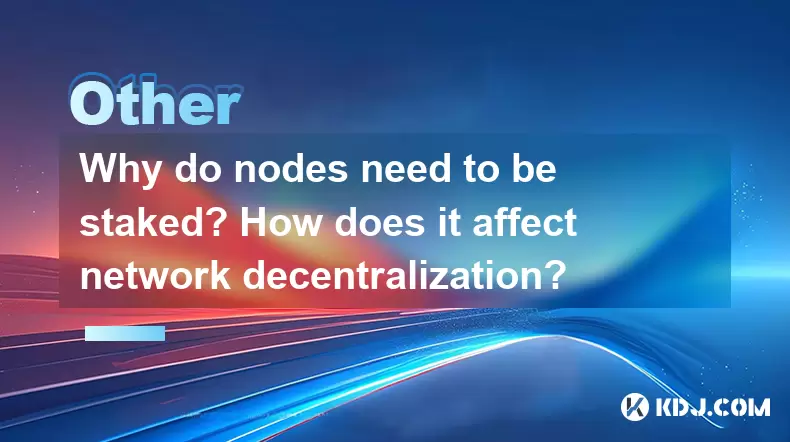
Introduction to Node Staking
Staking is a fundamental concept in many blockchain networks, particularly those that operate on a Proof of Stake (PoS) consensus mechanism. In these networks, nodes are required to stake a certain amount of cryptocurrency to participate in the validation and creation of new blocks. This process not only incentivizes honest behavior but also plays a crucial role in maintaining the network's security and decentralization. Understanding why nodes need to be staked and how it affects network decentralization is essential for anyone interested in the mechanics of blockchain technology.
The Role of Staking in Blockchain Networks
In a blockchain network that utilizes a Proof of Stake consensus mechanism, staking serves multiple purposes. The primary function of staking is to secure the network by requiring participants to lock up a portion of their cryptocurrency as collateral. This collateral acts as a deterrent against malicious behavior, as participants risk losing their stake if they attempt to validate fraudulent transactions or engage in other harmful activities.
Additionally, staking helps in the selection of validators. In PoS networks, the probability of being chosen to validate a new block is often directly proportional to the amount of cryptocurrency staked. This means that participants with more stake have a higher chance of being selected, which encourages them to hold and stake more cryptocurrency, thereby increasing the overall security of the network.
Impact of Staking on Network Decentralization
Network decentralization is a core principle of blockchain technology, aimed at preventing any single entity from gaining control over the network. Staking plays a significant role in maintaining this decentralization. By requiring nodes to stake cryptocurrency, the network ensures that participants have a vested interest in the network's success and integrity. This vested interest helps to prevent centralization, as it becomes economically unfeasible for a single entity to control a majority of the network's stake.
However, staking can also present challenges to decentralization if not implemented carefully. If the minimum stake required to participate is too high, it may exclude smaller participants, leading to a concentration of power among wealthier stakeholders. Conversely, if the staking requirements are too low, it might not provide sufficient security against malicious actors. Therefore, the design of staking mechanisms must strike a balance to ensure both security and decentralization.
The Process of Staking a Node
Staking a node involves several steps, and the exact process can vary depending on the specific blockchain network. Here is a general outline of the steps involved in staking a node:
- Choose a Blockchain Network: Select a network that supports staking, such as Ethereum 2.0, Cardano, or Tezos.
- Acquire the Required Cryptocurrency: Ensure you have enough of the network's native cryptocurrency to meet the minimum staking requirements.
- Set Up a Wallet: Use a compatible wallet that supports staking. Some networks may require specific types of wallets, such as hardware wallets for added security.
- Stake Your Cryptocurrency: Follow the network's specific instructions to lock up your cryptocurrency as stake. This often involves transferring the cryptocurrency to a designated staking address.
- Run a Node: Set up and run a node on your computer or a server. This node will participate in the validation process and help maintain the network.
- Monitor and Manage Your Stake: Keep an eye on your stake and the performance of your node. Some networks allow you to add or remove stake as needed.
Benefits of Staking for Node Operators
For node operators, staking offers several benefits. Firstly, staked nodes can earn rewards for their participation in the validation process. These rewards are typically distributed in the form of additional cryptocurrency, providing a passive income stream for node operators. Secondly, staking can enhance the security of the network, which in turn increases the value and stability of the staked cryptocurrency.
Moreover, by participating in staking, node operators contribute to the decentralization of the network. This involvement can be particularly rewarding for those who believe in the principles of blockchain technology and wish to support the development of a more decentralized and secure ecosystem.
Challenges and Considerations in Staking
While staking offers numerous benefits, it also comes with its own set of challenges and considerations. One of the main challenges is the technical complexity involved in setting up and maintaining a node. This can be a barrier for less technically savvy individuals, potentially limiting the number of participants and affecting decentralization.
Another consideration is the lock-up period associated with staking. In many networks, staked cryptocurrency is locked up for a certain period, during which it cannot be traded or used for other purposes. This lock-up period can be a deterrent for some participants, especially if they need liquidity.
Additionally, the risk of slashing is a significant consideration. In some networks, if a validator acts maliciously or fails to perform their duties correctly, they can lose a portion of their stake. This risk must be carefully managed by node operators to ensure they do not suffer financial losses.
Frequently Asked Questions
Q: Can staking be done on mobile devices?
A: Yes, some blockchain networks offer mobile staking options through compatible wallets. However, running a full node typically requires more computational power and is usually done on a computer or server.
Q: What happens to my stake if the network is attacked?
A: In the event of a network attack, the security measures in place, such as slashing, are designed to penalize malicious actors. If you are a honest staker, your stake should remain safe, though network-wide issues could potentially affect the value of the cryptocurrency.
Q: How does staking differ from mining in terms of environmental impact?
A: Staking is generally considered more environmentally friendly than mining, which requires significant computational power and energy consumption. Staking relies on the amount of cryptocurrency staked rather than computational power, resulting in a lower environmental footprint.
Q: Are there any legal considerations I should be aware of when staking?
A: The legal landscape surrounding staking can vary by jurisdiction. It's important to research and understand the regulations in your area, as some countries may have specific rules regarding the staking of cryptocurrency.
Disclaimer:info@kdj.com
The information provided is not trading advice. kdj.com does not assume any responsibility for any investments made based on the information provided in this article. Cryptocurrencies are highly volatile and it is highly recommended that you invest with caution after thorough research!
If you believe that the content used on this website infringes your copyright, please contact us immediately (info@kdj.com) and we will delete it promptly.
- HashKey Chain integration with KuCoin exchange is now live. Users can directly withdraw $HSK tokens to the HashKey Chain mainnet.
- 2025-05-16 17:00:13
- USD1, the Trump family's stablecoin project, has attracted widespread market attention
- 2025-05-16 17:00:13
- Ukraine is considering setting up a National Bitcoin Reserve
- 2025-05-16 16:55:13
- Sleep Token Have Released Another Cryptic Message This Morning (May 16)
- 2025-05-16 16:55:13
- Institutional Investors Continued to Pour Capital into US-Listed Spot Bitcoin ETFs
- 2025-05-16 16:50:12
- Bitcoin (BTC) Price Today: BTC Explodes Above $104,000, Targeting $109,396 Resistance
- 2025-05-16 16:50:12
Related knowledge
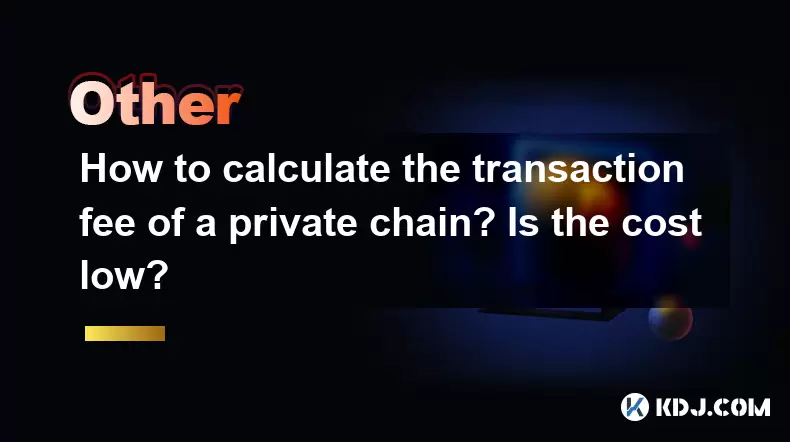
How to calculate the transaction fee of a private chain? Is the cost low?
May 16,2025 at 05:14am
How to Calculate the Transaction Fee of a Private Chain? Is the Cost Low? In the world of cryptocurrencies, understanding the transaction fees associated with different types of blockchains, including private chains, is crucial for users and developers alike. A private chain, also known as a permissioned blockchain, is a blockchain network where access ...
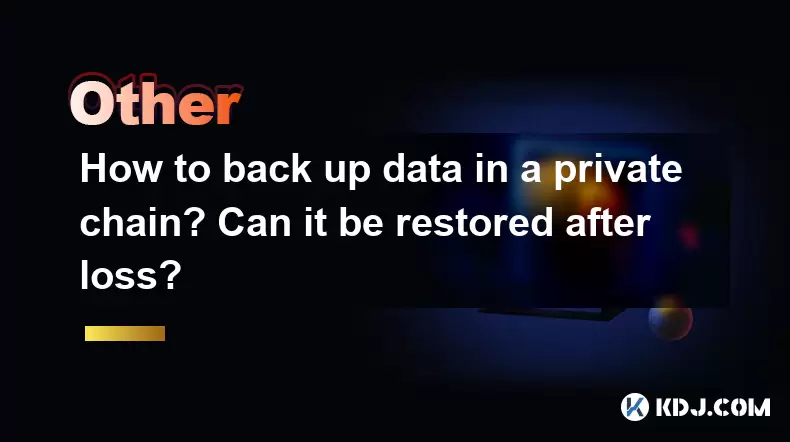
How to back up data in a private chain? Can it be restored after loss?
May 16,2025 at 12:36pm
Introduction to Private Chain Data BackupBacking up data in a private chain is crucial for maintaining the integrity and continuity of your blockchain operations. Private chains, also known as permissioned blockchains, are used by organizations to ensure data privacy and control over network participants. In this article, we will explore the methods for...
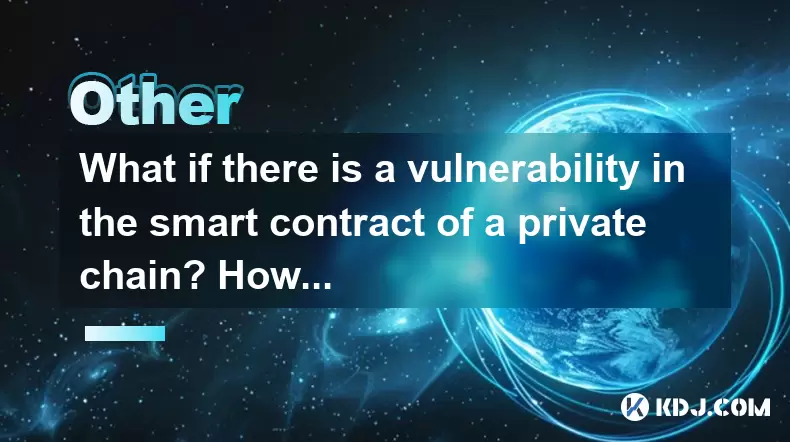
What if there is a vulnerability in the smart contract of a private chain? How to fix it?
May 15,2025 at 08:02pm
Introduction to Smart Contract Vulnerabilities in Private ChainsSmart contracts are self-executing programs that run on blockchain technology, designed to automate transactions and enforce agreements. While they offer numerous benefits, such as transparency and immutability, they are not immune to vulnerabilities. When a vulnerability is found in the sm...
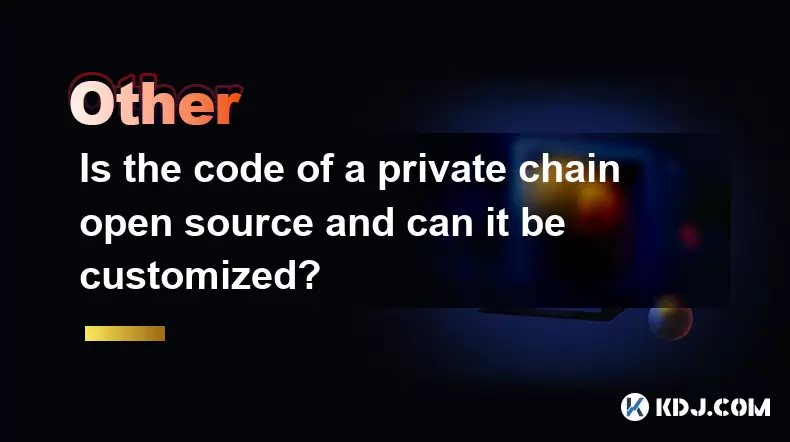
Is the code of a private chain open source and can it be customized?
May 15,2025 at 09:49pm
In the world of cryptocurrencies and blockchain technology, private chains or permissioned blockchains have become a topic of interest for many enterprises and organizations. A private chain is a blockchain network where access is restricted to a specific group of participants, as opposed to public blockchains like Bitcoin and Ethereum, which are open t...
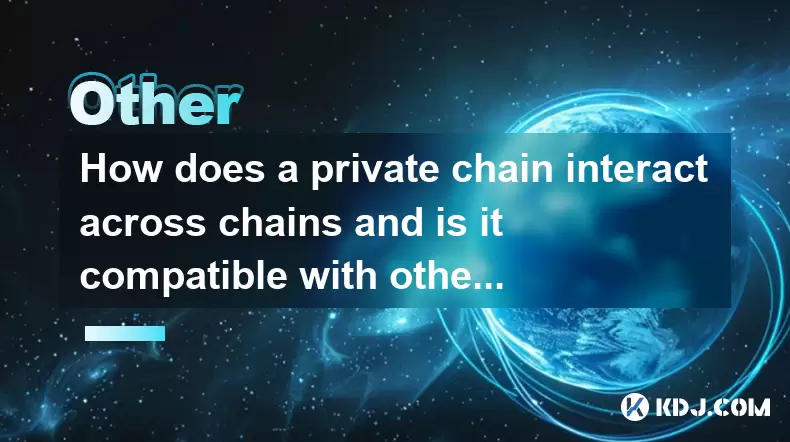
How does a private chain interact across chains and is it compatible with other chains?
May 15,2025 at 04:07pm
Understanding Private Chains and Their FunctionalityA private chain, also known as a permissioned blockchain, is a type of blockchain network where access and participation are controlled by a single organization or a consortium of organizations. Unlike public blockchains, where anyone can join and participate, private chains are restricted to a select ...
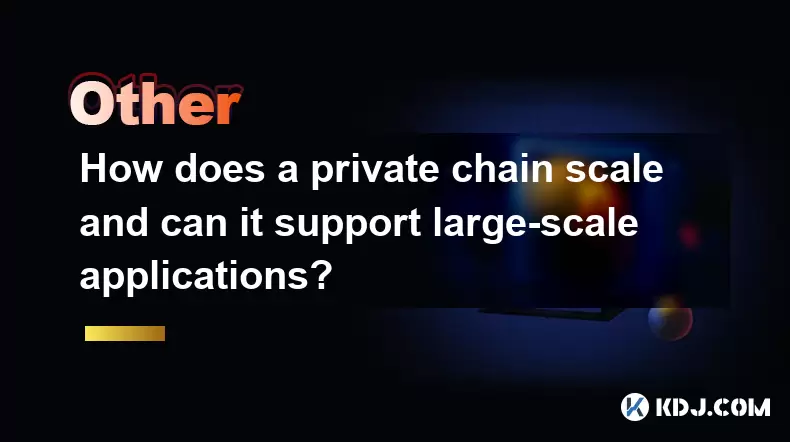
How does a private chain scale and can it support large-scale applications?
May 15,2025 at 03:00pm
Introduction to Private ChainsPrivate chains, also known as permissioned blockchains, are networks where access is restricted to a specific group of users. Unlike public blockchains, which are open to anyone, private chains offer more control over who can participate and what transactions can be processed. This controlled environment makes private chain...

How to calculate the transaction fee of a private chain? Is the cost low?
May 16,2025 at 05:14am
How to Calculate the Transaction Fee of a Private Chain? Is the Cost Low? In the world of cryptocurrencies, understanding the transaction fees associated with different types of blockchains, including private chains, is crucial for users and developers alike. A private chain, also known as a permissioned blockchain, is a blockchain network where access ...

How to back up data in a private chain? Can it be restored after loss?
May 16,2025 at 12:36pm
Introduction to Private Chain Data BackupBacking up data in a private chain is crucial for maintaining the integrity and continuity of your blockchain operations. Private chains, also known as permissioned blockchains, are used by organizations to ensure data privacy and control over network participants. In this article, we will explore the methods for...

What if there is a vulnerability in the smart contract of a private chain? How to fix it?
May 15,2025 at 08:02pm
Introduction to Smart Contract Vulnerabilities in Private ChainsSmart contracts are self-executing programs that run on blockchain technology, designed to automate transactions and enforce agreements. While they offer numerous benefits, such as transparency and immutability, they are not immune to vulnerabilities. When a vulnerability is found in the sm...

Is the code of a private chain open source and can it be customized?
May 15,2025 at 09:49pm
In the world of cryptocurrencies and blockchain technology, private chains or permissioned blockchains have become a topic of interest for many enterprises and organizations. A private chain is a blockchain network where access is restricted to a specific group of participants, as opposed to public blockchains like Bitcoin and Ethereum, which are open t...

How does a private chain interact across chains and is it compatible with other chains?
May 15,2025 at 04:07pm
Understanding Private Chains and Their FunctionalityA private chain, also known as a permissioned blockchain, is a type of blockchain network where access and participation are controlled by a single organization or a consortium of organizations. Unlike public blockchains, where anyone can join and participate, private chains are restricted to a select ...

How does a private chain scale and can it support large-scale applications?
May 15,2025 at 03:00pm
Introduction to Private ChainsPrivate chains, also known as permissioned blockchains, are networks where access is restricted to a specific group of users. Unlike public blockchains, which are open to anyone, private chains offer more control over who can participate and what transactions can be processed. This controlled environment makes private chain...
See all articles























































































